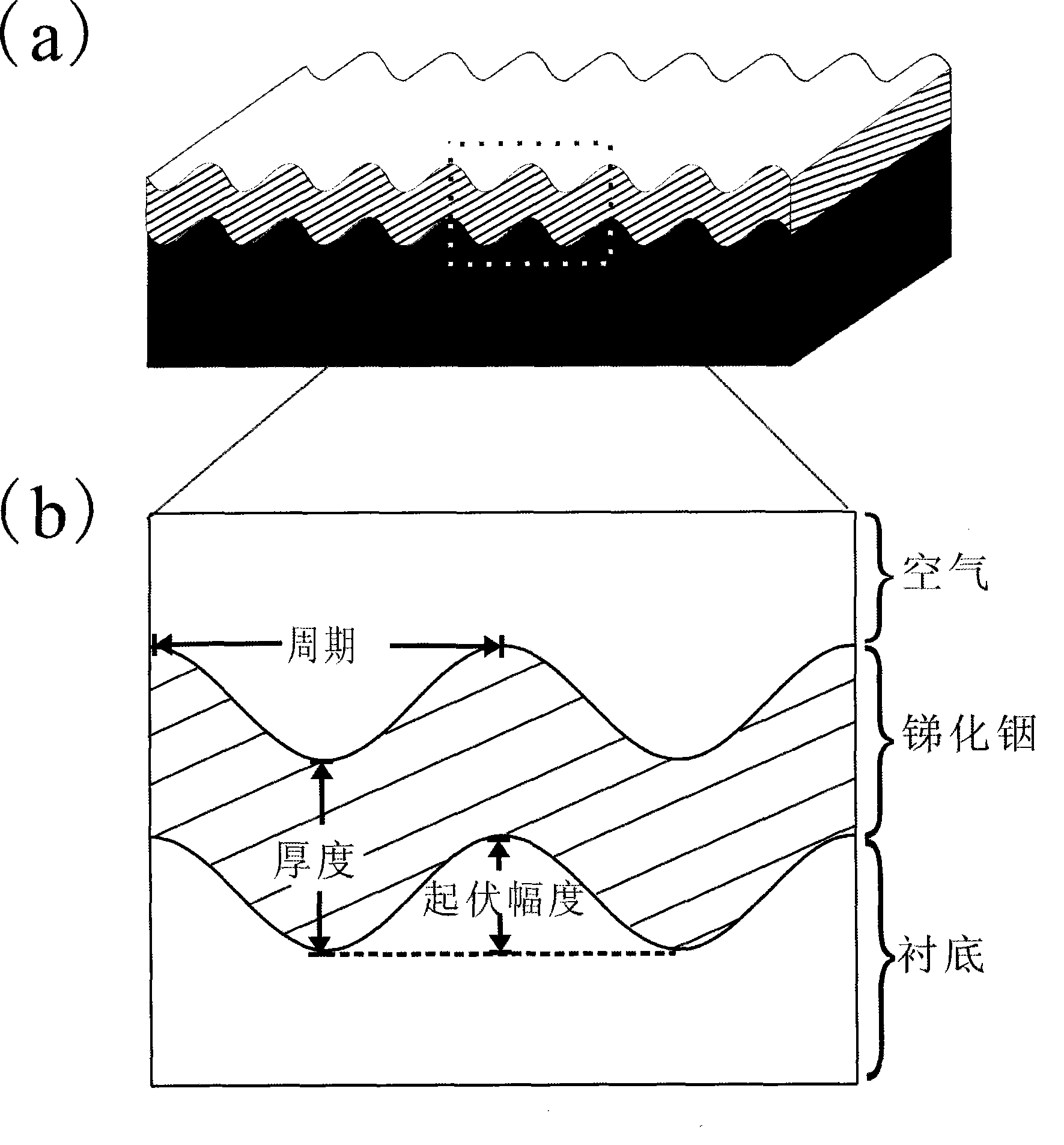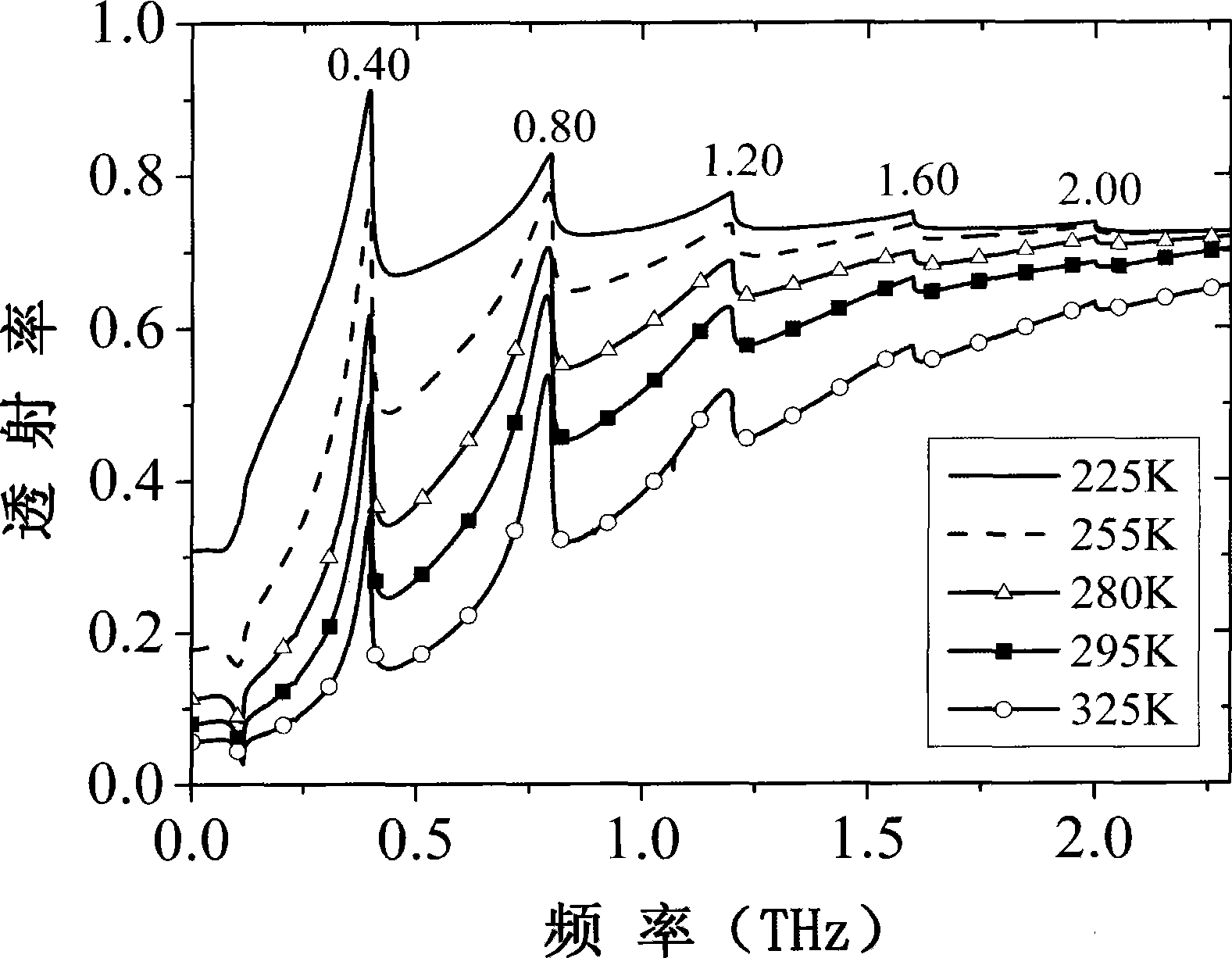Ultra-thin multi-channel terahertz filter having temperature regulation
A multi-channel and filter technology, applied in the field of multi-channel terahertz filters, can solve the problems of difficult adjustment of slit width, thick indium antimonide film, low transmittance of terahertz light, etc.
- Summary
- Abstract
- Description
- Claims
- Application Information
AI Technical Summary
Problems solved by technology
Method used
Image
Examples
Embodiment 1
[0030] In embodiment 1, the substrate is selected as high-impedance single crystal silicon, and the film material is undoped indium antimonide (InSb). The surface of the substrate is made into a sinusoidal surface shape (period 750 microns, surface fluctuation amplitude 150 microns) by photolithography, and then a layer of InSb film (thickness 2.0 microns) is grown on the sinusoidal surface of the substrate surface by laser deposition technology, This multi-channel terahertz filter structure has five resonance modes obtained in the electromagnetic wave frequency range of 0.1 to 3 terahertz, namely: 0.40 terahertz, 0.80 terahertz, 1.20 terahertz, 1.60 terahertz and 2.00 terahertz , when the ambient temperature decreases from 325K to 225K, these five resonance frequencies basically do not change with temperature, but their transmittance increases with the decrease of temperature, and the transmittance can reach up to 90%. Therefore, this multi-channel terahertz filter structure,...
Embodiment 2
[0031] In embodiment 2, the substrate is selected as gallium arsenide, and the thin film material is undoped InSb. The surface of the substrate is etched into a sinusoidal surface shape (period 750 microns, surface undulation amplitude 150 microns) by photolithography and other techniques. Then a layer of InSb thin film (thickness 2 microns) is grown on the sinusoidal surface of the substrate surface by laser deposition technology. This multi-channel terahertz filter has five resonant modes obtained in the electromagnetic wave frequency range of 0.1 to 3 terahertz, namely: 0.40 terahertz, 0.80 terahertz, 1.20 terahertz, 1.60 terahertz and 2.00 terahertz, When the ambient temperature decreases from 325K to 225K, these five resonance frequencies basically do not change with temperature, but their transmittance increases with the decrease of temperature, and the transmittance can reach up to 90%. Therefore, this multi-channel terahertz filter, in which the film thickness does no...
Embodiment 3
[0032] In embodiment 3, the substrate is selected as high-impedance single crystal silicon, and the film material is undoped indium antimonide (InSb). The surface of the substrate was made into a sinusoidal surface shape (period 600 microns, surface undulation amplitude 120 microns) by photolithography. Then a layer of InSb thin film (thickness 2.0 microns) is grown on the sinusoidal surface of the substrate by laser deposition technology. This multi-channel terahertz filter has five resonant modes obtained in the electromagnetic wave frequency range of 0.1 to 3 terahertz, namely: 0.50 terahertz, 1.00 terahertz, 1.50 terahertz, 2.00 terahertz and 2.50 terahertz, When the ambient temperature decreases from 325K to 225K, these five resonance frequencies basically do not change with temperature, but their transmittance increases with the decrease of temperature, and the transmittance can reach up to 93%. Therefore, this multi-channel terahertz filter, in which the film thickness...
PUM
| Property | Measurement | Unit |
|---|---|---|
| Thickness | aaaaa | aaaaa |
| Thickness | aaaaa | aaaaa |
Abstract
Description
Claims
Application Information
 Login to View More
Login to View More - R&D Engineer
- R&D Manager
- IP Professional
- Industry Leading Data Capabilities
- Powerful AI technology
- Patent DNA Extraction
Browse by: Latest US Patents, China's latest patents, Technical Efficacy Thesaurus, Application Domain, Technology Topic, Popular Technical Reports.
© 2024 PatSnap. All rights reserved.Legal|Privacy policy|Modern Slavery Act Transparency Statement|Sitemap|About US| Contact US: help@patsnap.com










